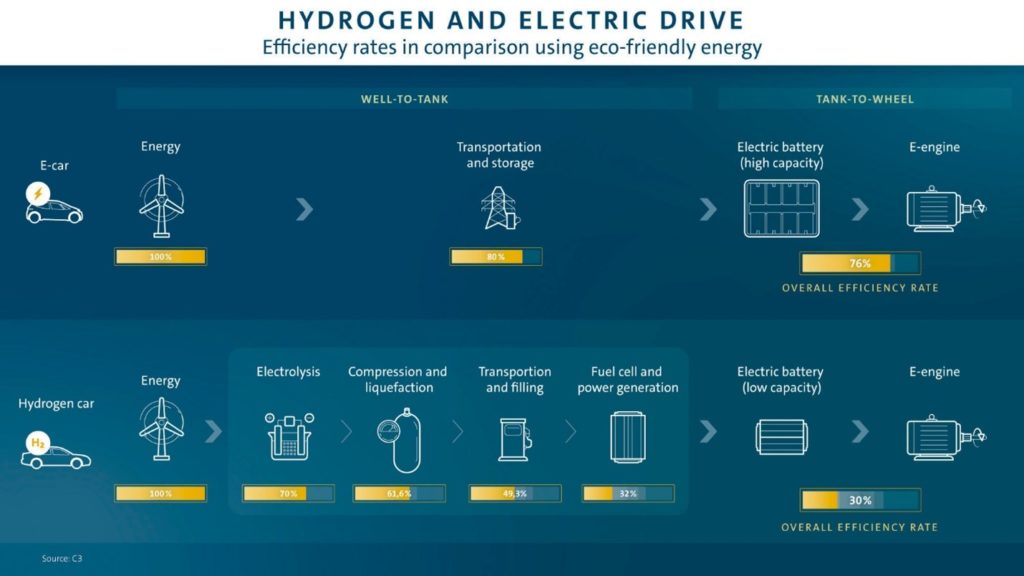For supporters, expectations are high that green hydrogen will become the fuel of the future. But for critics, green hydrogen is a, complex, expensive and energy intensive process for storing power. It would require a massive amount of renewable energy generation to meet just 25% of energy demand, which is the estimated amount needed to hit policymakers’ 2050 goal of limiting global warming to 1.5 degrees.
Achieving such a goal with hydrogen would require more electricity than is currently created by all sources worldwide, says a March 2020 report, “Hydrogen Economy Outlook,” by BloombergNEF. It would also require an $11 trillion dollar investment to build the necessary production, storage, and transportation infrastructure.
Electrolysis, the process of splitting water into hydrogen and oxygen, is extremely inefficient, with a 70% loss of efficiency during the manufacturing, transportation, and distribution of hydrogen (See the chart below). It may make sense for energy intensive heavy industries like chemical, steel, and iron or long-haul transportation such as heavy trucks & shipping, but probably does not for use in passenger cars. Elon Musk refers to hydrogen fuel cells as “Fool Sells.” Joe D’Allego of CNBC writes (abridged):
“Fuel cells = fool sells,” Tesla CEO Elon Musk tweeted on June 10. “Staggeringly dumb,” he continued. As CNBC noted, Musk has previously “dismissed hydrogen fuel cells as ‘mind-bogglingly stupid.'” He has also “called them ‘fool cells,’ a ‘load of rubbish,’ and told Tesla shareholders at an annual meeting years ago that ‘success is simply not possible.'”
Clearly, Musk is not a fan of hydrogen fuel cells — at least not for use in cars — which makes sense since he built the Tesla empire on lithium-ion batteries.
The debate between lithium-ion and hydrogen has raged for decades. Both can be used as clean, zero-emission alternatives to fossil fuels, but while hydrogen fuel cells have been around much longer (indeed, it is what NASA used to put men on the moon in 1969), it was lithium-ion batteries that ultimately proved much easier to commercialize, particularly for use in passenger cars.
Part of that is because hydrogen fuel cells are more complex; they generate energy by creating and harnessing chemical reactions between hydrogen and oxygen while leaving water vapor as the only emission. And while hydrogen is lightweight, incredibly efficient and the most abundant resource in the universe, it currently takes a lot of energy to harness hydrogen.
“Hydrogen is an energy storage mechanism. It’s not a source of energy,” Musk said at a 2015 press conference. “Electrolysis is extremely inefficient as an energy process. If you took a solar panel and used the energy from that solar panel to just charge your battery pack directly compared to trying to split water, take the hydrogen, dump the oxygen, compress the hydrogen to an extremely high pressure or liquefy it and then put it in a car and run a fuel cell, it is about half the efficiency. It’s terrible.”
Green Hydrogen Systems Electrolyser: How it Works
Steve Schneider
Latest posts by Steve Schneider (see all)
- New Chinese Electromagnetic Surveillance Leaves “Nowhere to Hide” on Battlefield - March 15, 2024
- Amazon’s Nuclear Powered Data Center - March 7, 2024
- Skunk Works Rolls Out An Engineering Marvel - March 6, 2024
- Future of Airpower Takes First Flight - March 4, 2024
- A War Beneath the Waves – Trillions of Dollars at Stake - February 9, 2024
















